Internal Flow in an Enhanced Tube Having Square-cut Twisted Tape Insert
Abstract
:1. Introduction
2. Numerical Method
3. Results and Discussion
4. Concluding Remarks
- Nu, f, and η of both the CTTs and STTs with various pitch ratios of the enhanced tube are higher compared to those of the plain tube. the decrease of the pitch ratio leads to the increase of Nu, f, and η.
- STT with y/W = 2.7 yields higher heat transfer rate, friction factor, and thermal performance factor.
- The highest increases in Nu and f of the enhanced tube can reach 81% and 3.3 times greater than ones of the smooth tube, respectively.
- The thermal performance factor has been visualized and it can reach a value of 1.23.
- Based on both the temperature and velocity distributions at the cross sections, the heat transfer mechanism has been definitely evaluated.
Author Contributions
Funding
Acknowledgments
Conflicts of Interest
References
- Honda, H.; Wijayanta, A.T.; Takata, N. Condensation of R407C in a horizontal microfin tube. Int. J. Refrig. 2005, 28, 203–211. [Google Scholar] [CrossRef]
- Xue, Y.; Ge, Z.; Du, X.; Yang, L. On the heat transfer enhancement of plate fin heat exchanger. Energies 2018, 11, 1398. [Google Scholar] [CrossRef]
- Xue, B.; Tahara, K.; Nakashima, K.; Noda, A.; Oktariani, E.; Wijayanta, A.T.; Nakaso, K.; Fukai, J. Numerical simulation for steam generation process in a novel zeolite-water adsorption heat pump. J. Chem. Eng. Jpn. 2012, 45, 408–416. [Google Scholar] [CrossRef]
- Fukai, J.; Wijayanta, A.T. Potential ability of zeolite to generate high-temperature vapor using waste heat. AIP Conf. Proc. 2018, 1931, 020001. [Google Scholar] [CrossRef]
- Yaningsih, I.; Wijayanta, A.T.; Miyazaki, T.; Koyama, S. Analysis of heat and mass transfer characteristics of desiccant dehumidifier system with honeycomb configuration. Appl. Therm. Eng. 2018, 144, 658–669. [Google Scholar] [CrossRef]
- Kristiawan, B.; Santoso, B.; Juwana, W.E.; Ramadhan, R.M.; Riandana, I. Numerical investigation of laminar convective heat transfer for TiO2/water nanofluids using two-phase mixture model (Eulerian approach). AIP Conf. Proc. 2017, 1788, 030002. [Google Scholar] [CrossRef]
- Kristiawan, B.; Santoso, B.; Wijayanta, A.T.; Aziz, M.; Miyazaki, T. Heat transfer enhancement of TiO2/water nanofluid at laminar and turbulent flows: A numerical approach for evaluating the effect of nanoparticle loadings. Energies 2018, 11, 1584. [Google Scholar] [CrossRef]
- Wijayanta, A.T.; Miyazaki, T.; Koyama, S. Liquid-vapor phase distribution in horizontal headers with upward minichannel-branching conduits. Exp. Therm. Fluid Sci. 2016, 76, 264–274. [Google Scholar] [CrossRef]
- Wijayanta, A.T.; Miyazaki, T.; Koyama, S. Refrigerant distribution in horizontal headers with downward minichannel-branching conduits: Experiment, empirical correlation and two-phase flow pattern map. Exp. Therm. Fluid Sci. 2017, 81, 430–444. [Google Scholar] [CrossRef]
- Wijayanta, A.T.; Miyazaki, T.; Koyama, S. Note on refrigerant R134a flow maldistribution in a header type evaporator. Int. J. Refrig. 2018, 95, 1–9. [Google Scholar] [CrossRef]
- Wijayanta, A.T.; Istanto, T.; Kariya, K.; Miyara, A. Heat transfer enhancement of internal flow by inserting punched delta winglet vortex generators with various attack angles. Exp. Therm. Fluid Sci. 2017, 87, 141–148. [Google Scholar] [CrossRef]
- Yaningsih, I.; Wijayanta, A.T.; Miyazaki, T.; Koyama, S. Impact of blockage ratio on thermal performance of delta-winglet vortex generators. Appl. Sci. 2018, 8, 181. [Google Scholar]
- Yaningsih, I.; Wijayanta, A.T.; Miyazaki, T.; Koyama, S. Thermal hydraulic characteristics of turbulent single-phase flow in an enhanced tube using louvered strip insert with various slant angles. Int. J. Therm. Sci. 2018, 134, 355–362. [Google Scholar] [CrossRef]
- Wijayanta, A.T.; Yaningsih, I.; Aziz, M.; Miyazaki, T.; Koyama, S. Double-sided delta-wing tape inserts to enhance convective heat transfer and fluid flow characteristics of a double-pipe heat exchanger. Appl. Therm. Eng. 2018, 145, 27–37. [Google Scholar] [CrossRef]
- Wijayanta, A.T.; Aziz, M.T.; Kariya, K.; Miyara, A. Numerical study of heat transfer enhancement of internal flow using double-sided delta-winglet tape insert. Energies 2018, 11, 3170. [Google Scholar] [CrossRef]
- Ray, S.; Date, A.W. Friction and heat transfer characteristics of flow through square duct with twisted tape insert. Int. J. Heat Mass Transf. 2003, 46, 889–902. [Google Scholar] [CrossRef]
- Yaningsih, I.; Istanto, T.; Wijayanta, A.T. Experimental study of heat transfer enhancement in a concentric double pipe heat exchanger with different axial pitch ratio of perforated twisted tape inserts. AIP Conf. Proc. 2016, 1717, 030012. [Google Scholar] [CrossRef]
- Yaningsih, I.; Wijayanta, A.T.; Miyazaki, T.; Koyama, S. V-cut twisted tape insert effect on heat transfer enhancement of single phase turbulent flow heat exchanger. AIP Conf. Proc. 2018, 1931, 030038. [Google Scholar] [CrossRef] [Green Version]
- Bellos, E.; Tzivanidis, C. Enhancing the performance of evacuated and non-evacuated parabolic trough collectors using twisted tape inserts, perforated plate inserts and internally finned absorber. Energies 2018, 11, 1129. [Google Scholar] [CrossRef]
- Patil, A.G. Laminar flow heat transfer and pressure drop characteristics of power-law fluids inside tubes with varying width twisted tape inserts. J. Heat Transf. 2000, 122, 143–149. [Google Scholar] [CrossRef]
- Saha, S.K.; Dutta, A.; Dhal, S.K. Friction and heat transfer characteristics of laminar swirl flow through a circular tube fitted with regularly spaced twisted-tape elements. Int. J. Heat Mass Transf. 2001, 44, 4211–4223. [Google Scholar] [CrossRef]
- Eiamsa-ard, S.; Wongcharee, K.; Sripattanapipat, S. 3-D Numerical simulation of swirling flow and convective heat transfer in a circular tube induced by means of loose-fit twisted tapes. Int. Commun. Heat Mass Transf. 2009, 36, 947–955. [Google Scholar] [CrossRef]
- Eiamsa-ard, S.; Thianpong, C.; Eiamsa-ard, P.; Promvonge, P. Convective heat transfer in a circular tube with short-length twisted tape insert. Int. Commun. Heat Mass Transf. 2009, 36, 365–371. [Google Scholar] [CrossRef]
- Jaisankar, S.; Radhakrishnan, T.K.; Sheeba, K.N.; Suresh, S. Experimental investigation of heat transfer and friction factor characteristics of thermosyphon solar water heater system fitted with spacer at the trailing edge of Left–Right twisted tapes. Energy Convers. Manag. 2009, 50, 2638–2649. [Google Scholar] [CrossRef]
- Eiamsa-ard, S.; Thianpong, C.; Eiamsa-ard, P.; Promvonge, P. Thermal characteristics in a heat exchanger tube fitted with dual twisted tape elements in tandem. Int. Commun. Heat Mass Transf. 2010, 37, 39–46. [Google Scholar] [CrossRef]
- Eiamsa-ard, S.; Seemawute, P.; Wongcharee, K. Influences of peripherally-cut twisted tape insert on heat transfer and thermal performance characteristics in laminar and turbulent tube flows. Exp. Therm. Fluid Sci. 2010, 34, 711–719. [Google Scholar] [CrossRef]
- Murugesan, P.; Mayilsamy, K.; Suresh, S. Turbulent heat transfer and pressure drop in tube fitted with square-cut twisted tape. Chin. J. Chem. Eng. 2010, 18, 609–617. [Google Scholar] [CrossRef]
- Murugesan, P.; Mayilsamy, K.; Suresh, S.; Srinivasan, P.S.S. Heat transfer and pressure drop characteristics in a circular tube fitted with and without V-cut twisted tape insert. Int. Commun. Heat Mass Transf. 2011, 38, 329–334. [Google Scholar] [CrossRef]
- Bhuiya, M.M.K.; Chowdhury, M.S.U.; Saha, M.; Islam, M.T. Heat transfer and friction factor characteristics in turbulent flow through a tube fitted with perforated twisted tape inserts. Int. Commun. Heat Mass Transf. 2013, 46, 49–57. [Google Scholar] [CrossRef]
- Salam, B.; Biswas, S.; Saha, S.; Bhuiya, M.M.K. Heat Transfer Enhancement in a Tube using Rectangular-cut Twisted Tape Insert. Proc. Eng. 2013, 56, 96–103. [Google Scholar] [CrossRef] [Green Version]
- Fu, W.; Tseng, C. Enhancement of heat transfer for a tube with an inner tube insertion. Int. J. Heat Mass Transf. 1994, 37, 499–509. [Google Scholar] [CrossRef]
- Zimparov, V. Prediction of friction factors and heat transfer coefficients for turbulent flow in corrugated tubes combined with twisted tape inserts. Part 2: Heat transfer coefficients. Int. J. Heat Mass Transf. 2004, 47, 385–393. [Google Scholar] [CrossRef]
- ANSYS Fluent 15.0: Theory Guide; Fluent Inc.: Canonsburg, PA, USA, 2010.
- Cengel, Y.A.; Ghajar, A.J. Heat and Mass Transfer: Fundamentals and Applications, 5th ed.; McGraw-Hill: New York, NY, USA, 2014. [Google Scholar]
- White, F.M. Fluid Mechanics, 7th ed.; McGraw-Hill: New York, NY, USA, 2011. [Google Scholar]
- Saha, S.K.; Tiwari, M.; Sundén, B.; Wu, Z. Advances in Heat Transfer Enhancement; Springer: Cham, Switzerland, 2016. [Google Scholar]

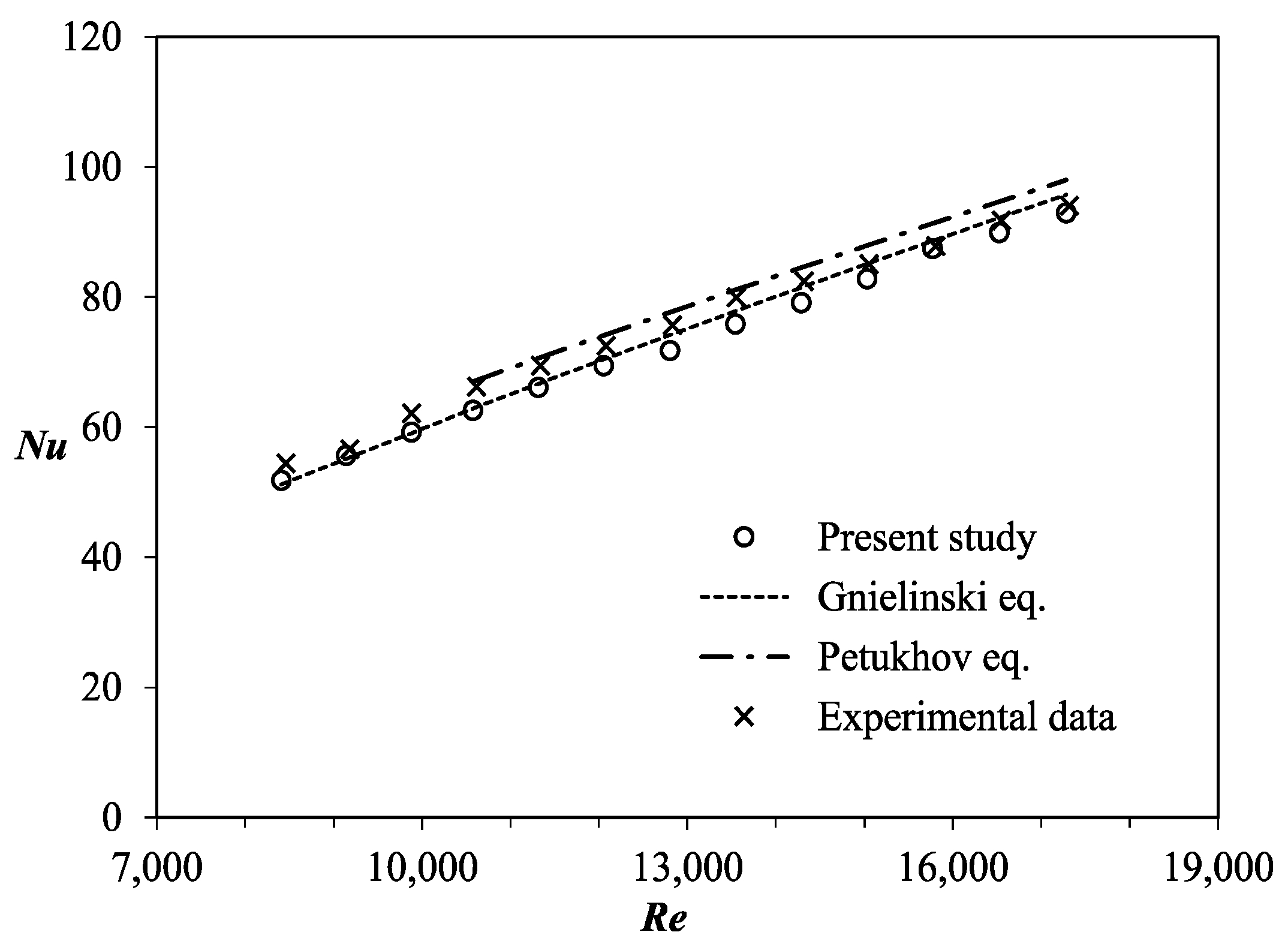

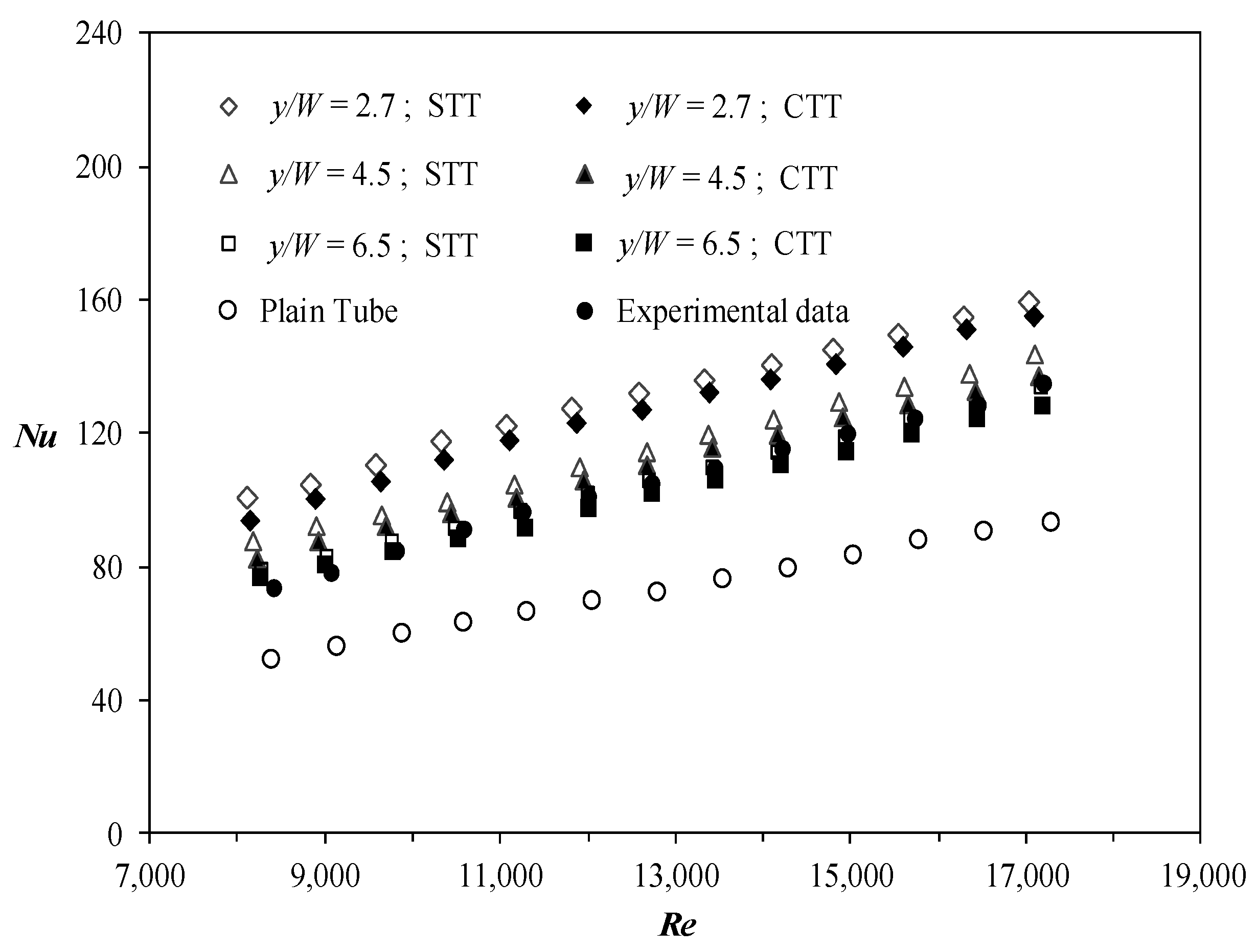

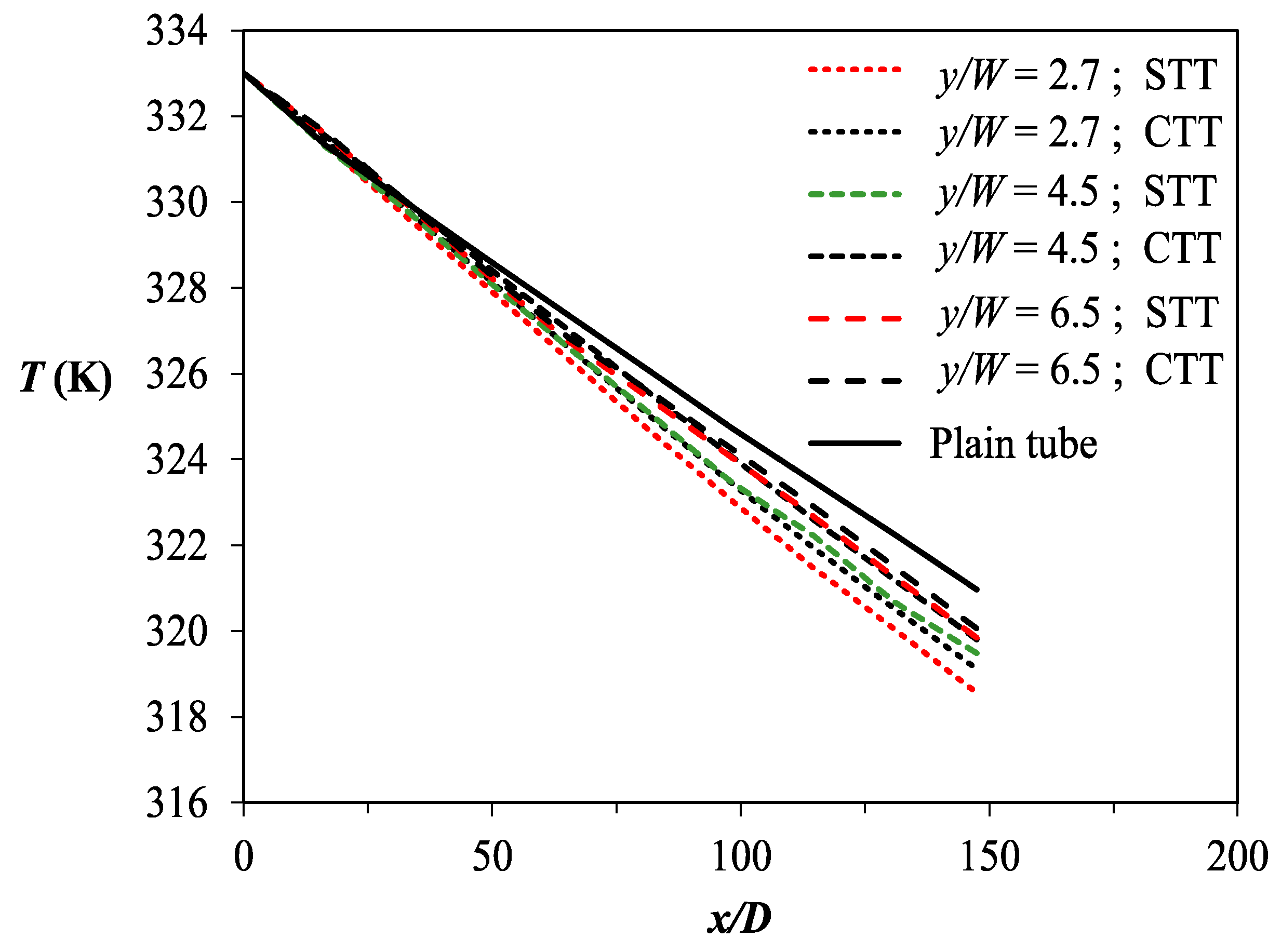

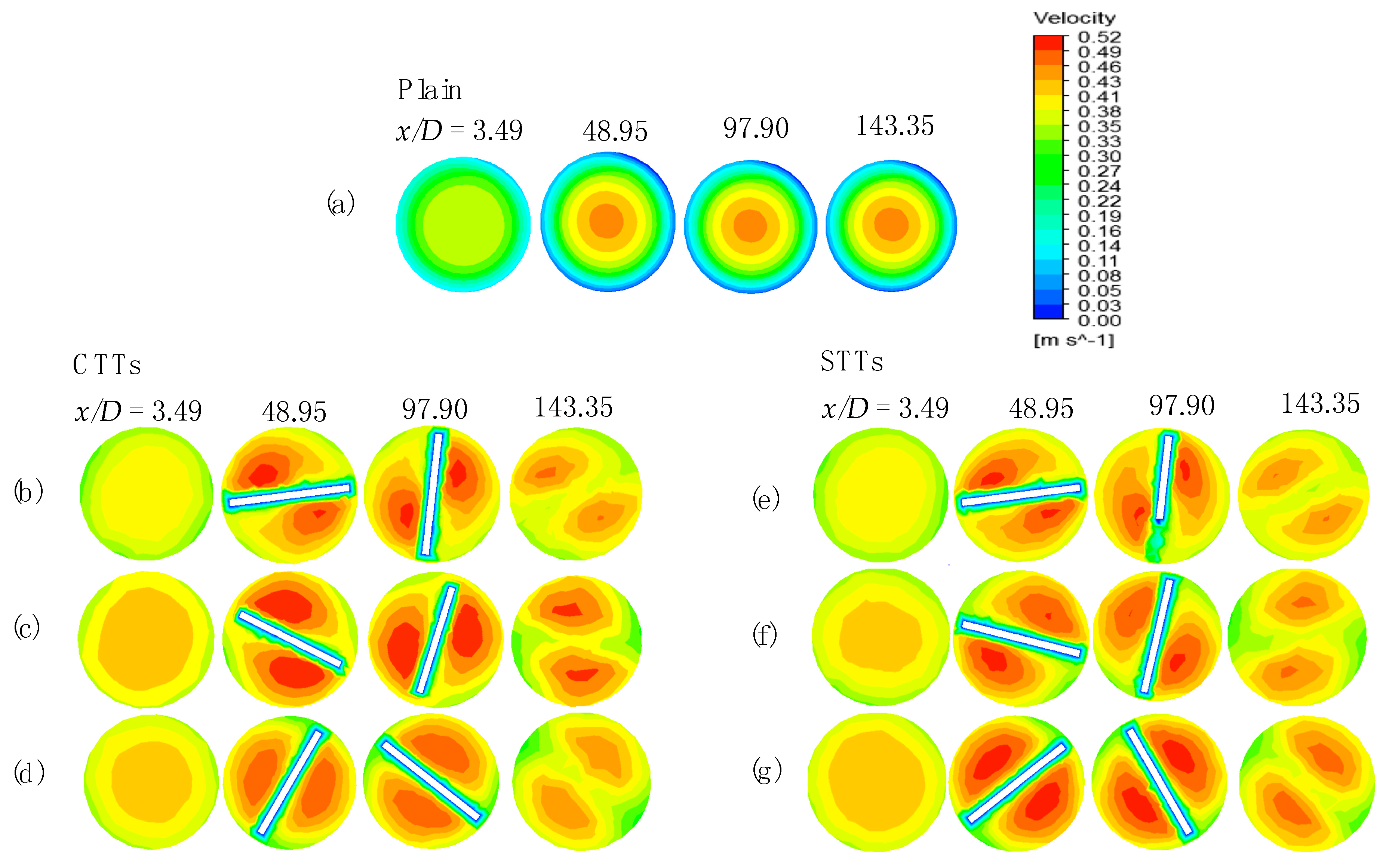
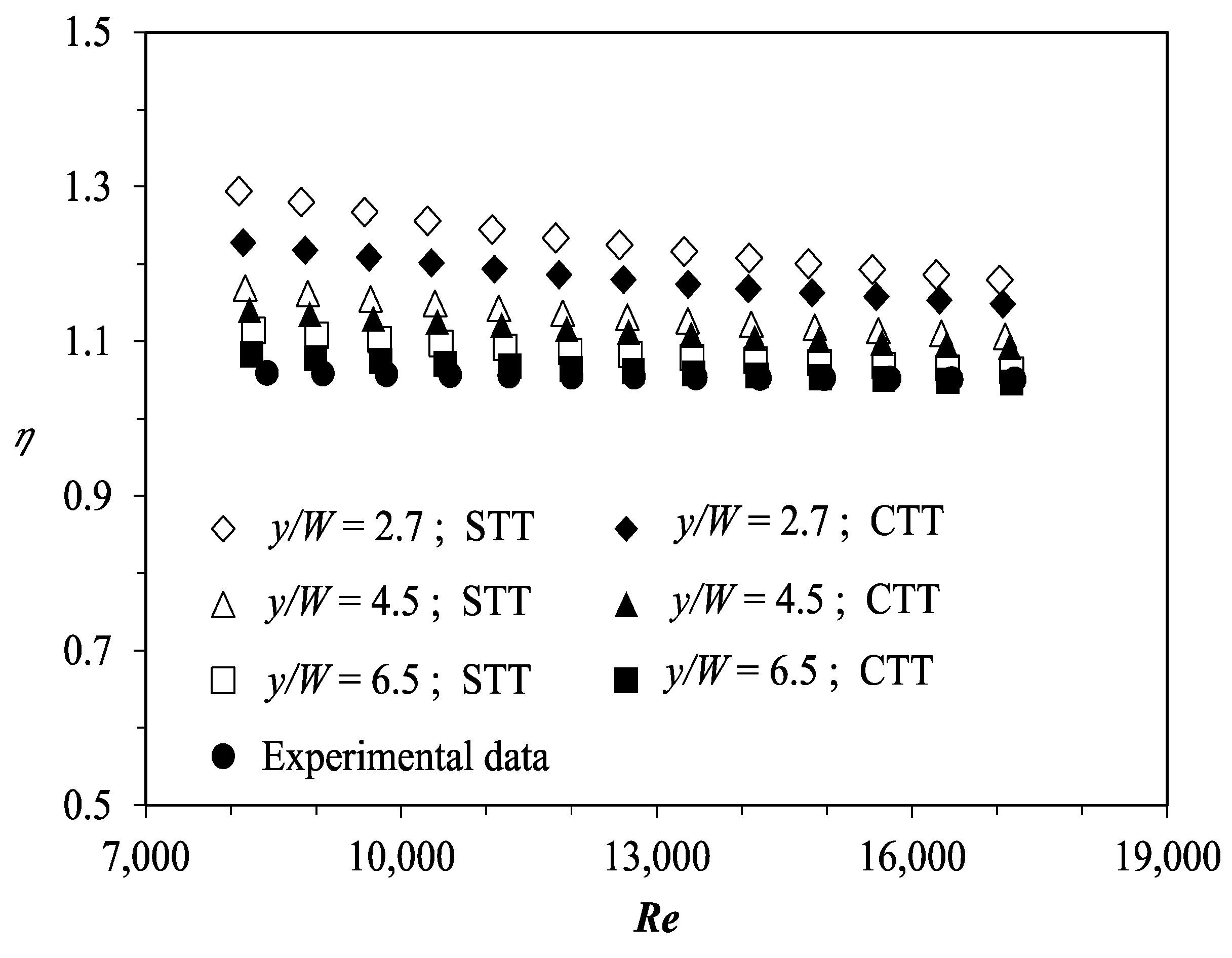
| Fluid | Temperature [K] | Heat Capacity Cp [kJ/kg⋅K] | Dynamic Viscosity μ [kg/m⋅s] | Thermal Conductivity k [W/m⋅K] | Density ρ [kg/m3] | Prandtl Number Pr |
|---|---|---|---|---|---|---|
| Hot water | 333.15 | 4.185 | 4.67(10−4) | 0.654 | 983.3 | 2.99 |
| Cold water | 300.15 | 4.178 | 8.52(10−4) | 0.613 | 997 | 5.81 |
© 2019 by the authors. Licensee MDPI, Basel, Switzerland. This article is an open access article distributed under the terms and conditions of the Creative Commons Attribution (CC BY) license (http://creativecommons.org/licenses/by/4.0/).
Share and Cite
Wijayanta, A.T.; Pranowo; Mirmanto; Kristiawan, B.; Aziz, M. Internal Flow in an Enhanced Tube Having Square-cut Twisted Tape Insert. Energies 2019, 12, 306. https://doi.org/10.3390/en12020306
Wijayanta AT, Pranowo, Mirmanto, Kristiawan B, Aziz M. Internal Flow in an Enhanced Tube Having Square-cut Twisted Tape Insert. Energies. 2019; 12(2):306. https://doi.org/10.3390/en12020306
Chicago/Turabian StyleWijayanta, Agung Tri, Pranowo, Mirmanto, Budi Kristiawan, and Muhammad Aziz. 2019. "Internal Flow in an Enhanced Tube Having Square-cut Twisted Tape Insert" Energies 12, no. 2: 306. https://doi.org/10.3390/en12020306






